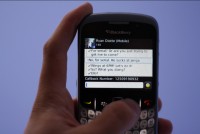OMG! How NOT to Write Business Web Content
 In today’s text, Twitter, social media world, people are getting more and more lazy about their grammar and spelling, according to This Embarrasses You and I*, an article in the Wall Street Journal.
In today’s text, Twitter, social media world, people are getting more and more lazy about their grammar and spelling, according to This Embarrasses You and I*, an article in the Wall Street Journal.
The article begins with:
When Caren Berg told colleagues at a recent staff meeting, “There’s new people you should meet,” her boss Don Silver broke in. “I cringe every time I hear” people misuse “is” for “are,” Mr. Silver says. He also hammers interns to stop peppering sentences with “like.” For years, he imposed a 25-cent fine on new hires for each offense. “I am losing the battle,” he says.
And it’s not just Mr. Silver who is losing the battle. Companies across the country are fighting the same and it’s becoming an epidemic.
Schools have stopped teaching cursive handwriting. That makes sense, of course, as many of us no longer write longhand. But, along with it comes shorthand acronyms – LOL, WTH, *$, 2nite, <3, AISI, IMO, OMG – and they’re all reaching corporate world communications.
Heck, they had to create an entire dictionary on the lingo so those of us who didn’t grow up in the text world know how to understand what’s being said.
But it’s not just affecting the business world. According to BBC News, students are turning in homework completely written in text.
My smmr hols wr CWOT. B4, we used 2go2 NY 2C my bro, his GF & thr 3 :- kids FTF. ILNY, it’s a gr8 plc.
It’s fairly easy to figure out this person went to NY to see her brother and his family during summer break, but it certainly takes more energy and thought to figure out what message is being delivered.
If this is how your customers and prospects are being communicated to/with, do you think they’re going to want to do business with you?
But it’s not just text speak that is bringing down the corporate world of writing and communications. Most don’t know the difference between their, they’re, and there.
Following are six tips for better business writing. And, if you’re so inclined, for better Facebook status updates, too.
- Always use spell check. Internet browsers, content management systems, Pages, Word, and most software have spell check built in. Use it!
- Cut down on text slang. We all use LOL or OMG or WTH with the best of them, but when writing, spell out your acronyms. You don’t say LOL when you speak. Don’t write it, either.
- Know the difference between your and you’re. Your is possessive, as in “your car” or “your business.” You’re is short for you are. Know which you’re trying to say.
- Same for its and it’s. It’s is short for it is. Read your sentence out loud. If you can say “it is” without it sounding goofy, it’s is the proper use. If it sounds ridiculous, you can use its.
- The word “that” is rarely necessary. If you can write the sentence without the word “that,” remove it. It’s very rare it’s a necessity.
- Stop using the word “like.” Just like Don Silver in the example like above, like too many people like use the word like.
If you want to get serious about your writing, check out the Associated Press Stylebook, the Chicago Manual of Style, or Strunk and White’s Elements of Style.
 About the Author ~ Gini Dietrich
About the Author ~ Gini Dietrich
Gini Dietrich is the founder and CEO of Arment Dietrich, a Chicago-based integrated marketing communications firm. She is the author of the PR and marketing blog Spin Sucks and co-author (with Geoff Livingston) of the book, Marketing in the Round. You can find her on Twitter, Google+, Pinterest, and Facebook.
photo thanks to proudcanadianeh




Well said! Perhaps I’m just too old or too dense, but I can’t make head nor tail of text-speak and it has no place on business websites.
I’m with you, Joy. I’m all about texting and Twitter and the like, but I don’t think it needs to make us lazy writers. It has no place in business, period.
Good lord, obviously you didn’t have enough on your plate and now you are out pimpin’ guest posting gigs? Oops, I slanged in pimpin’, didn’t I?
I try to be cognizant of my audience (was cognizant and good recovery from pimpin’?) as I want to be understood. It’s very easy for me to slip into slang or southern, but it just depends on who I’m with.
However, and the gist of your post is people don’t necessarily write to their audience; they write to what they know.
Is it the new norm and are we ‘old-school’ trying to hold the line?
Good post and great tips especially on the Spell check that most of them forget to do
Great article, but I tripped up on point #4. It’s is NOT possessive but does mean “it is”. I’m sure that was just an error but it sure popped out at me.
Bill, Bill. You have to be nice to me in other people’s homes. At least put on a front!
Stanley, the only thing I would add with spellcheck is to not rely solely on it. For instance, if I forgot the “L” in public, spellcheck wouldn’t pick that up and I’d be really embarrassed.
Lydia, UG! Yes! I realized that mistake yesterday and quickly asked Laura to edit it for me. As it turns out, I’m not perfect, which is really going to hurt my mom’s feelings. :)